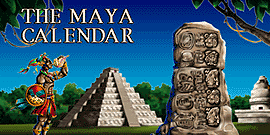The Maya Stela represent a date in the long count Maya calendar, also
called the Initial Series. The stela is read from top to bottom and each gliph
has a meaning. See table besides.
The first row has the Introductory glyph. All important dates have one preceding
the calendric count, basically it says: "Here comes an important date".
From rows 2 to 6 all the glyphs represent different time periods, their names
and duration in days are described in the table. These glyphs all have numbers
preceding them which indicate how many of these time periods (Baktun = 144,000
days, Katun = 7,200 days, Tun = 360 days, Uinal = 20 days, Kin = 1 day) have
passed since the Maya Calendar's starting date, Aug. 13, 3114 BC.
The glyphs and numbers of the last two rows (7,8) show the denomination of
the day and the month of the Calendar Round, which is the current 52 year Maya
time period. The day corresponds to the Maya Calendar Tzolkin and the month
to the Haab Maya Calendar.
The correlation factor used in all our calculations is the Goodman-Martinez-Thompson
(GMT)+2 correlation, i.e. with the correlation constant of 584 285. Orbital phenomena of the planet Venus, observed by ancient Maya astronomers (probably from the Venus-sanctuary on the island of Cozumel), with a zero error and recorded as such on page 24 of the Dresden codex as the Maya date equivalent to 16 November 934 A.D. (jul.) confirm the accuracy of this correlation.


